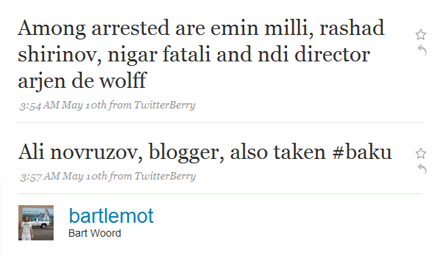Twitter, blogs, social media define youth protests in #baku, #azerbaijan
Defying earlier warnings, a group of youth activists last Sunday staged an action to protest the government’s failure to declare a national day of mourning after 13 people were killed in a shooting spree at a Baku university on 30 April. The tragedy shocked many both inside and outside Azerbaijan, but only a few took to the streets last week. Radio Free Europe, however, has been quick to term the young protesters "Baku’s Flower Children."
They laid flowers at the scene of the shooting and posted placards, some of which denounced official corruption. The authorities initially tolerated those protests, but as of May 4 police began systematically removing flowers and protest placards without any explanation. Several protesters were detained: five of them were sentenced on May 9 to between three and 10 days in jail.
The authorities ignored the students’ demands for a day of official mourning, and held the Flower Festival as planned. Police forcibly detained for several hours up to 50 young people who gathered in silent protest close to the main venue; some of them were reportedly beaten.
To be sure, the Baku protests were not as numerous as those in Moldova last month to protest the perceived falsification of the parliamentary elections. Nor were they as spectacularly violent and destructive.
But they appear to have followed much the same pattern, with disparate youth and student organizations communicating among themselves by e-mail to organize protests. […] link
Among those detained were several bloggers, including Frontline’s own Ali S. Novruzov, and social media tools such as Twitter were used to follow their arrest and later release. It is also believed that social networking sites such as Facebook were used to arrange and coordinate the protest in addition to those blogs which later carried many first-hand accounts of the incident.
Coordinated by various means, including online social networks such as Facebook, turnout for the peaceful protest last Sunday might have been small, but its significance was enough to force the hand of the authorities. The demonstration was dispersed and 50 people, including at least 3 bloggers, were detained.
[…]Tools such as Twitter were used to send out updates on the detentions. Although there are known problems with sending out tweets via SMS on certain cellular phone networks in Azerbaijan, one foreign blogger, International Federation of Liberal Youth General Secretary Bart Woord, updated followers from his Blackberry via Twitter’s web interface.
Global Voices Online and Global Voices Advocacy were quick to respond and spread the word while the Committee to Protect Bloggers also followed up on the detentions. Meanwhile, OL!, a progressive Azeri youth movement notable for its use of new media, also sent out similar tweets.
Of course, the main accounts came after those detained were released and video interviews were posted on the OL! blog. […] link
One of those bloggers, regional analyst Arzu Geybullayeva, also wrote an article on the protest and detentions for the online Italian magazine Osservatorio Balcani e Caucaso. Interestingly, the unprecedented use of social media tools by activists in the region followed the publication of my article in the same magazine on the use of new media by civil society and political activists by only a few days.
Certainly, the use of online tools by alternative voices in the South Caucasus is now beyond doubt. As mentioned in an earlier post, however, what remains to be seen is how quickly governments in the region will respond to a new online threat which challenges their control of news and information. For now, with internal security services in Armenia paying increased attention to online activity, signs are that such a move might come sooner rather than later.


